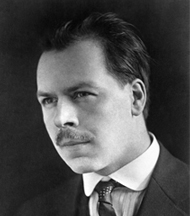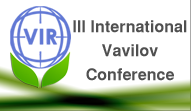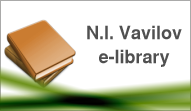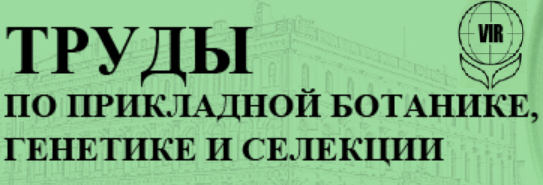COMMENT ON THE CONCLUSION OF THE EXPERT GROUP (CONTINUATION)
In the first part a reader had an opportunity to get acquainted with the recitals of the “Conclusion of the expert group” as well as comment on them.
Below you can find “Proposals of the expert group” as well as comment on them.
- To extend the basis for development of agriculture production it`s recommended for the Ministry of economic development of Russia to initiate a rapid elaboration of the Federal Law «On genetic resources», as well as adoption of a Federal Program on revealing and conservation of plant genetic resources.
During 10 years, beginning from 2000, VIR has repeatedly forwarded requests on establishing juridical and legal basis for working with plant genetic resources (PGR) to different Government authorities and State leaders, as well as proposals to adopt a project of the National Program. In reply to all requests there have been received letters supporting these initiatives, but without further promotion (VIR archive disposes of the documents` originals).
So, 26.07.2000 VIR forwarded a letter to the President of Russia (№ АГ-ПI-21607) with proposals to be added to the National Project on Russia`s entering into FAO, as well as prepared materials regarding the Russian National Program on conservation and use of PGR with the purpose of entering the uniform global system on mobilization and conservation of agrobiodiversity. 17.08.2000 in reply to this letter VIR received a response signed by the Vice-Minister of the Ministry of economic development of Russia М.Yu. Medvedkov (№ ММ-84/15-56/1569). It stated: «the Ministry of economic development considers it necessary to develop a National program … and proposes to establish an interagency commission on preparing relevant proposals… From its side the Ministry is ready to take part in the commission work…». And that`s all!
14.05.2002 a meeting of a board under the Ministry of industry, science and technology of Russia on mobilization and conservation of genetic resources of plants, animals, microorganisms and cell cultures was held. The board decided «…to develop and present in August 2003 … draft regulations on Russian PGR collections». And that`s all!
14.06.2002 VIR addressed the President of RAAS Romanenko G.A. with a request to forward a letter supporting approval of the Russian National Program on PGR to the Ministry of industry. The letter was forwarded, but there was no answer.
25.07.2003 VIR addressed the representative of the Russian President in the North-Western Region V.I. Matvienko with a request to forward a letter (№ 5-26/5764) to the Ministry of economic development on establishing a National coordinating committee on agrobiodiversity under the Ministry of Agricultural of Russia and development of National program on mobilization and preservation of agrobiodiversity. The response stated: «…the Ministry is going to announce in 2004 a tender on developing a draft concept and targeted program «National program of Russia on agrobiodiversity for food and agriculture». And that`s all!
22 December 2006 the State Duma adopted a Federal Law of Russia № 264-FZ «On development of agriculture». While preparing the law VIR repeatedly introduced proposals on legal status of PGR collections for food and agriculture, but in the final variant of the law they were not reflected.
In 2008, understanding the importance and need of legislative aspects for PGR, Inter-Parliamentary Assembly of CIS countries addressed VIR with the purpose to develop a Model Law «On conservation of plant genetic resources and their rational use». The project of this law was developed by VIR specialists and adopted during thirty third meeting of the Inter-Parliamentary Assembly of CIS countries (resolution №33-8 as of 3 December 2009). Individual CIS countries are already developing their National laws on its basis.
2. To include VIR and its experiment station network into the system of the Russian Academy of Science with consequent assigning a status “National Heritage of Russia” to VIR collection
It`s quite clear why members of the expert group didn`t have a common view on the VIR/RAS integration issue. We join those experts who question such a decision. Totally unacceptable is the proposal of the expert group member А. Timonin who has said that "in RAAS system collection is more endangered than in RAS", since we shouldn`t speak about larger or smaller grade of «evil», but about safe preservation of the collection material.
Some authors of the «Conclusion» do think the collection is less endangered in the RAS system. Do highly respected experts, who propose this way of salvation of VIR and its collections, know that costs for proper maintenance of the collection could be compared with the budget of no less than 5-6 institutes? How in the situation of decreasing to 30% RAS budget it can ensure activities of the Institute on collection, preservation and study of PGR, its 12 experiment stations and branches, while taking into account that personnel of VIR system makes 1000 people including 41 Senior Doctors and 158 PhD-Doctors?
At present trade unions and staff members of institutes under RAS encourage their colleagues to go on strikes with slogans like «save Russian science», «increase salary», «improve capacity building and provide accommodation for scientists».
Till recently scientists hoped that one of the decisions of financial problems can be rental money, but in vain. In 2010 processing of documents regarding rental of temporary unused territories has complicated. As a result, a great part of institutes doesn`t get rental money from the beginning of the year. Thus, its absence while deficit of the budget caused though the budget sequester of RAS as well as inflation may result in communal crisis. (POISK № 39 as of 24th of September 2010)
Perhaps the bright spot on the background of this sad picture is for RAS a housing construction issue?
In December 2009 the President of Russia gave instruction to develop a mechanism of providing RAS staff members with affordable flats. As a result of this, on 27 of April 2010 RAS and RZHS have signed a bilateral agreement on providing accommodation for RAS. According to А. Braverman saying (Director of RZHS) 1 billion Rubles was appointed for this project in 2010 and at least the same amount - for the next three years. At present changes for law on RZHS are being prepared. They will let RAS transfer federal lands, not used for scientific proposes, to RZHS for housing construction for staff members of RAS!
In this scenario lands of VIR and its experiment station network (about 8 thousand ha) are a good hunk, because in Soviet times, as a rule, only best lands were allocated for agriculture production. Naturally, today they are of great interest by both commercial and government structures. May be that`s why staff members of RZHS attended all meetings of the expert group?
We fully agree with the proposal of experts to assign the status «National Heritage» to the collection, if it`s reflected in the Russian legislation. The explanatory dictionary gives the following definition: «NATIONAL HERITAGE- anything of national significance which is handed down and preserved through generations, esp. architecture, landscapes, documents, and other artifacts; also, a body set up to carry out this preservation» The paragraph 4 of the VIR Charter says: «Collection of plant genetic resources of the Institute – is one of the biggest in the world and richest in its botanical, genetic, geographic and ecological diversity. It`s a property of Russia and National heritage of the country. The Institute is its main creator, holder and keeper».
3. Plot №18 of 19,5 ha can be used for housing construction without damaging VIR collection.
Official report: plot No. 18 is used for crop rotation, it`s a place where a unique genepool of VIR world collection of perennial fodder crops is being preserved in vitro, regenerated and studied (3,5 – 5,0 thousand accessions annually).
Collection occupies 20% from the total area of the plot. About 60% of the area is used for crop rotation (stubble and fallow plots). The rest of the territory is occupied with shelter belts, driveways and utility buildings.
Conclusion of the expert group regarding the possibility of housing construction and «peaceful co-existence of groomed plantations and comfortable cottages» is completely unacceptable not only for VIR staff members, but also for specialists dealing with life collections of plant genetic resources. Such collections are not plantations. They originally were not designed for general public visits as for instance botanical gardens, objects of culture heritage and parks. World experience tells about total incompatibility of genetic resources and housing construction.
Besides that, what is the most important, the conclusion on possibility/impossibility of housing construction was out of the expert group competence.
Not questioning the high ranks of the expert group members, we pay your attention that the expert group included PhD- and Senior doctors of biological science as well as academicians, i.e. people having little idea about housing construction. Possibly they were guided by the staff members of RZHS who took part in all expert group meetings?
4. An area of about 13,2 ha occupied by VIR collection on plot №2 has to be secured for conservation of VIR collection.
We have already pointed out to the fact that the expert group has “overlooked” 10 ha of collection plantations as well as to that according to international standards a field genebank includes in addition to orchards also driveways, drain ditches, shelter belts, road network, fallow plots, discarded gardens (for stubbing) as well as nursery (in our case 19,7 ha)
«It`s necessary to provide spare territories of 20 ha on other plots of the Pavlovsk experiment station».
As it was previously said, there are no spare lands appropriate for orchards within the territory of the Pavlovsk experiment station, and those present are occupied by collections of pome fruits (apple, plum etc.). I.e. orchard, and furthermore collection itself encompassing a great amount of species, subspecies and varieties (it was confirmed by the expert group), but not a narrow set of commercialized varieties adapted for growing in this soil-climatic zone, cannot be grown at every free plot – it`s clear, as we think, to everybody and all the more to the expert group.
5. The expert group has come to the conclusion to change the Pavlovsk experiment station management.
It`s not clear enough, how the expert group came to such a conclusion? Firstly, according to the resolution of the Ministry of economic development this issue wasn`t posted in the tasklist of the expert group. Secondly, to do such conclusions it`s necessary to get acquainted with the Charter of the experiment station, Charter of VIR and that of RAAS as well as with scientific agreements, accounting records etc. (in the list of documents the expert group was working with, they were not indicated). There wouldn’t be also any harm of meeting with VIR staff members and collection curators.





